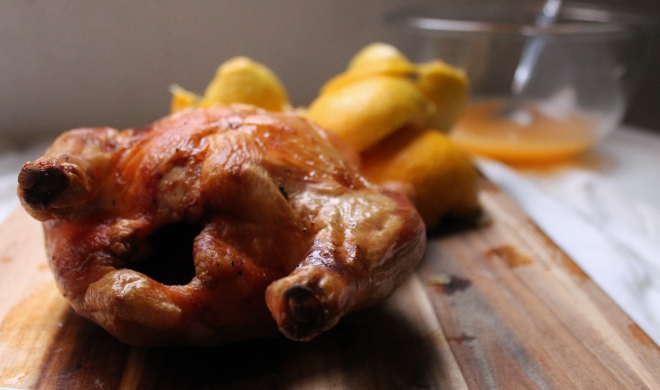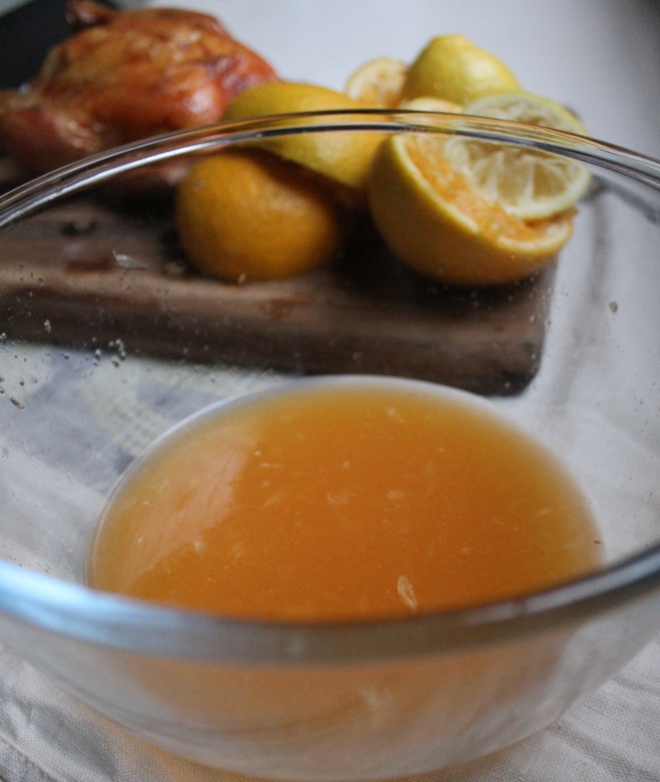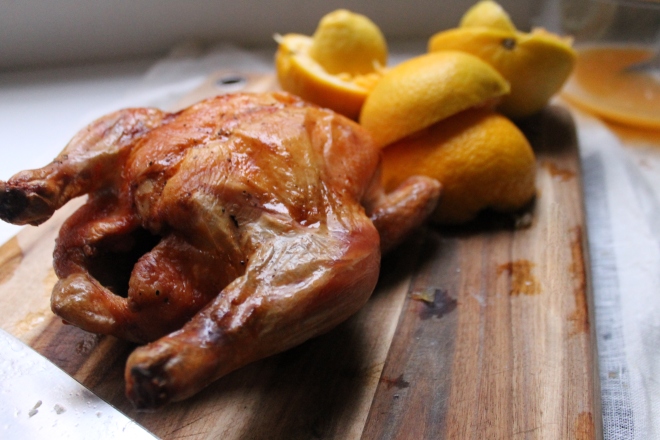 I felt that for the next Historical Food Fortnightly challenge, which was to make something with oranges, I wanted to do something that was a bit earlier in date. Flicking through ‘The Medieval Kitchen’ by Redon, Sabban and Serventi I stumbled across Chicken with Orange Sauce which sounded promising and was very budget friendly.
I felt that for the next Historical Food Fortnightly challenge, which was to make something with oranges, I wanted to do something that was a bit earlier in date. Flicking through ‘The Medieval Kitchen’ by Redon, Sabban and Serventi I stumbled across Chicken with Orange Sauce which sounded promising and was very budget friendly.
The recipe is a translation from Maestro Martino’s ‘Libro De Arte Coquinaria’ which was composed before 1465 (one of the versions is dedicated to his patron who died in that year).[1] Martino was the official cook for several important Italian gentlemen in the mid fifteenth century, and something of a celebrity chef. He was a part of an international network of courts that shared recipes and tastes, ‘De Arte Coquinaria’ shows affinities with Catalan manuscripts in particular.[2]
The Recipe
“Roast Chicken. To prepare roast chicken, you must roast it; and when it is cooked take orange juice or verjuice with rose water, sugar, and cinnamon, and place the chicken on a platter; and pour this mixture over it and send it to table.”[3]
What I soon discovered though, was that oranges in this period were not the sweet oranges which we are familiar with today. Originating in an area comprising north-eastern India, northern Myanmar and southern China, the bitter orange was brought to Europe via Islamic Spain.[4] Bitter oranges were used to give a sour taste to dishes, especially sauces, and could be used as an alternative to verjuice. Although there are some mentions of sweet oranges in the 15th century, it wasn’t until the 16th century that they were cultivated in Europe. It may be that it was the introduction of a new variety from China by Portugese traders that was the impetus for eating oranges as a fruit, rather than using them just for their sour juice (in much the same way as we use lemons today).[5] That the oranges called for in our recipe were bitter oranges is clear from the option to use verjuice instead.
![By Franz Eugen Köhler, Köhler's Medizinal-Pflanzen (List of Koehler Images) [Public domain], via Wikimedia Commons](https://turnspitandtable.files.wordpress.com/2015/05/citrus_aurantium_-_kc3b6hlere28093s_medizinal-pflanzen-042.jpg?resize=473%2C577)
Citrus Aurantium by Franz Eugen Köhler, Köhler’s Medizinal-Pflanzen [Public domain], via Wikimedia Commons
The Redaction
There are no quantities called for in the recipe, but as the authors of ‘The Medieval Kitchen’ provided a redaction of their own I saw no reason not to use their recipe, with one major exception. In the book, the authors say to use either bitter orange juice, or to use verjuice with rosewater. Having looked at the translation provided and, as much as possible with my basic Italian, the original recipe, I see no reason to read it as:
juice OR verjuice and rose water PLUS sugar and cinnamon
instead of:
juice OR verjuice PLUS rose water, sugar and cinnamon.
I also chose to add a bit of butter to the chicken, but that is a personal preference and you can certainly do as they suggest and use no fat. Of course, the original recipe calls for the chicken to be roasted, that is cooked in front of a fire, rather than baked in an oven, but if, like me, you don’t happen to have an open fire available then the oven will have to do.
Chicken with Orange Sauce
Adapted from ‘The Medieval Kitchen’ by Odile Redon, Francoise Sabban and Silvano Serventi.
1 chicken
Butter (optional)
Juice of 3 Seville oranges (or 2 sweet oranges and 1 lemon and omit the sugar) or 10 tbsp verjuice
1 tbsp rose water
1/2 tsp of sugar
1 pinch of ground cinnamon
- Pre-heat the oven to 200C. Place the chicken in a pan and, if desired, dot with pieces of butter. Bake until the chicken is golden and the juices run clear, basting frequently with the pan juices.
- Mix together the other ingredients in a bowl. Pour over the chicken and serve on a platter, or serve as a sauce with the chicken.
The Round-Up
The Recipe: Chicken with Orange Sauce from Maestro Martino’s ‘Libro De Arte Coquinaria’, translation in ‘The Medieval Kitchen’[7].
The Date: before 1465
How did you make it?: See above.
Time to complete?: The chicken took about an hour, the sauce itself was very quick.
How successful was it?: I liked the sauce, I was worried it would be very sweet but it wasn’t. It was a bit watery though, and I think it could have been even sourer. I would be interested to try it with Seville oranges if I can find them in season. It also made a lot of sauce for just one chicken, although it might not seem as much if you poured if over the chicken.
How accurate?: Well, I couldn’t get Seville oranges, I added a bit of butter, and I used an oven so it was really baked rather than roasted, so it could definitely be better.
[1] Nancy Harmon Jenkins, “Two Ways of Looking at Maestro Martino,” Gastronomica 7, no. 2 (2007): 97.
[2] Ibid.
[3] Odine Redon, Francoise Sabban, and Silvano Serventi, The Medieval Kitchen: Recipe from France and Italy, trans. Edward Schneider (Chicago & London: The University of Chicago Press, 1998), 115.
[4] Frederick G. Gmitter Jr. and Xulan Hu, “The Possible Role of Yunnan, China, in the Origin of Contemporary Citrus Species (Rutaceae),” Economic Botany 44, no. 2 (1990): 267–77; Clarissa Hyman, Oranges: A Global History (London: Reaktion Books, 2013), 7–13.
[5] Hyman, Oranges: A Global History, 13–17; Herbert John Webber, The Citrus Industry …, [1st ed]. (Berkeley, 1948), 12–14.
[6] Mark Morton, “Hue and Eye,” Gastronomica 11, no. 3 (2011): 6–7.
[7] Redon, Sabban, and Serventi, The Medieval Kitchen: Recipe from France and Italy, 115.
Bibliography
Gmitter, Frederick G., Jr., and Xulan Hu. “The Possible Role of Yunnan, China, in the Origin of Contemporary Citrus Species (Rutaceae).” Economic Botany 44, no. 2 (1990): 267–77.
Harmon Jenkins, Nancy. “Two Ways of Looking at Maestro Martino.” Gastronomica 7, no. 2 (2007): 97–103.
Hyman, Clarissa. Oranges: A Global History. London: Reaktion Books, 2013.
Morton, Mark. “Hue and Eye.” Gastronomica 11, no. 3 (2011): 6–7.
Redon, Odine, Francoise Sabban, and Silvano Serventi. The Medieval Kitchen: Recipe from France and Italy. Translated by Edward Schneider. Chicago & London: The University of Chicago Press, 1998.
Webber, Herbert John. “History and Development of the Citrus Industry.” In The Citrus Industry …, edited by Herbert John Webber, [1st ed]. Berkely: University of California Press, 1948.

